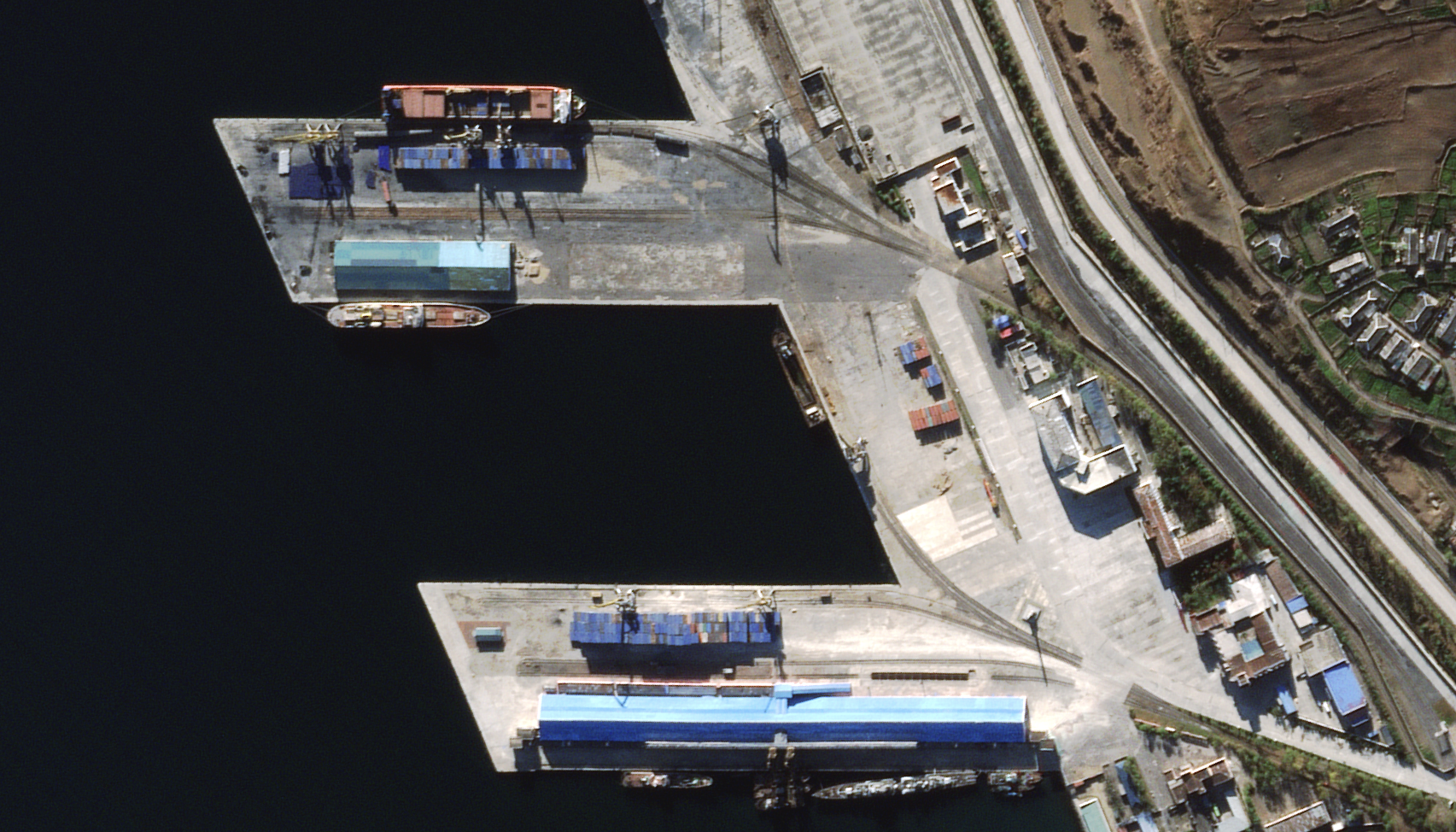
Activity at Najin Points to Continued DPRK-Russia Arms Transfers

Key Findings
- Satellite imagery analysis of Najin Port over the past two months shows that the port has been handling a significantly high level of activity. Given the White House confirmation that the port has been involved in the transfer of North Korean munitions to Russia, the recently observed activities suggest that such transfer activities are continuing.
- In at least two instances, Russian vessels previously identified as being involved in these transfers are observed again at Najin Port.
- The number of shipping containers and vessel movements at the port constantly varied in the images analyzed, showing levels of activity that were not typical at this location even before COVID.
- With continued public exposure detailing these operations, there is a reasonable expectation that North Korea and Russia will seek to obscure these sea transfers by changing ports or ships or by some other means.
- The ongoing arms transfer activity at Najin supplements rail traffic at the Tumangang-Khasan rail crossing between North Korea and Russia. These activities come after weeks of concerns over increased North Korean and Russian arms cooperation and directly violate multiple UN Security Council resolutions.
Since the October 2023 announcement by the White House confirming the transfer of North Korean “military equipment and munitions” to Russia from the Port of Najin, the port continues to display a high level of activity. To begin developing a more detailed understanding of the maritime trade between North Korea and Russia using the port of Najin, Beyond Parallel has monitored the port for two months using high-resolution satellite images collected on every week from October 10 to November 30, 2023.
It is necessary to note that satellite images are not available daily or consistently due to limitations of weather, collection patterns, and other factors. Additionally, satellite imagery cannot show what is inside these containers. However, the recent confirmation by the United States government on the port’s involvement in transferring military equipment and munitions between North Korea and Russia and the fact that the port has been showing an unusually high level of activity since then suggest such transfer activities continue.
Another challenge in the analysis is the definitive identification of whether the vessels observed at the port are loading or unloading. While an increase in shipping containers observed in imagery a day or two after a vessel has visited the pier could be interpreted as the vessel having unloaded containers originating from Russia, it is also necessary to consider the opposite: that is, since the vessel’s departure, more containers have been brought to port via the rail network from other parts of North Korea. Therefore, without multiple consecutive imagery collections of the pier on a day when a vessel has visited, it is challenging to determine whether a vessel is unloading or loading cargo conclusively.
However, regardless of the directionality of the shipping movement, it is clear that Najin Port has been handling a significantly high level of activity in recent weeks. The most notable activity observed at Najin Port occurred at Pier 2, Pier 3, and the quay between the two piers. No relevant activity was observed at Pier 1, the southernmost pier where a small pile of coal is stored.
The number of shipping containers and vessel activity at the three locations throughout Najin Port constantly varied in the eight satellite images analyzed, showing significant levels of activity that were not typical at this location even before COVID. In fact, images show that Pier 2 has historically been used to load coal until late 2022. Today, it serves as one of the two piers used to support the high level of cargo traffic occurring at the port.
Approximate count of shipping containers observed throughout Najin Port from October 10 to November 30, 2023. Asterisks indicate dates when container vessels were present.
Activity at Najin Port
October 10, 2023
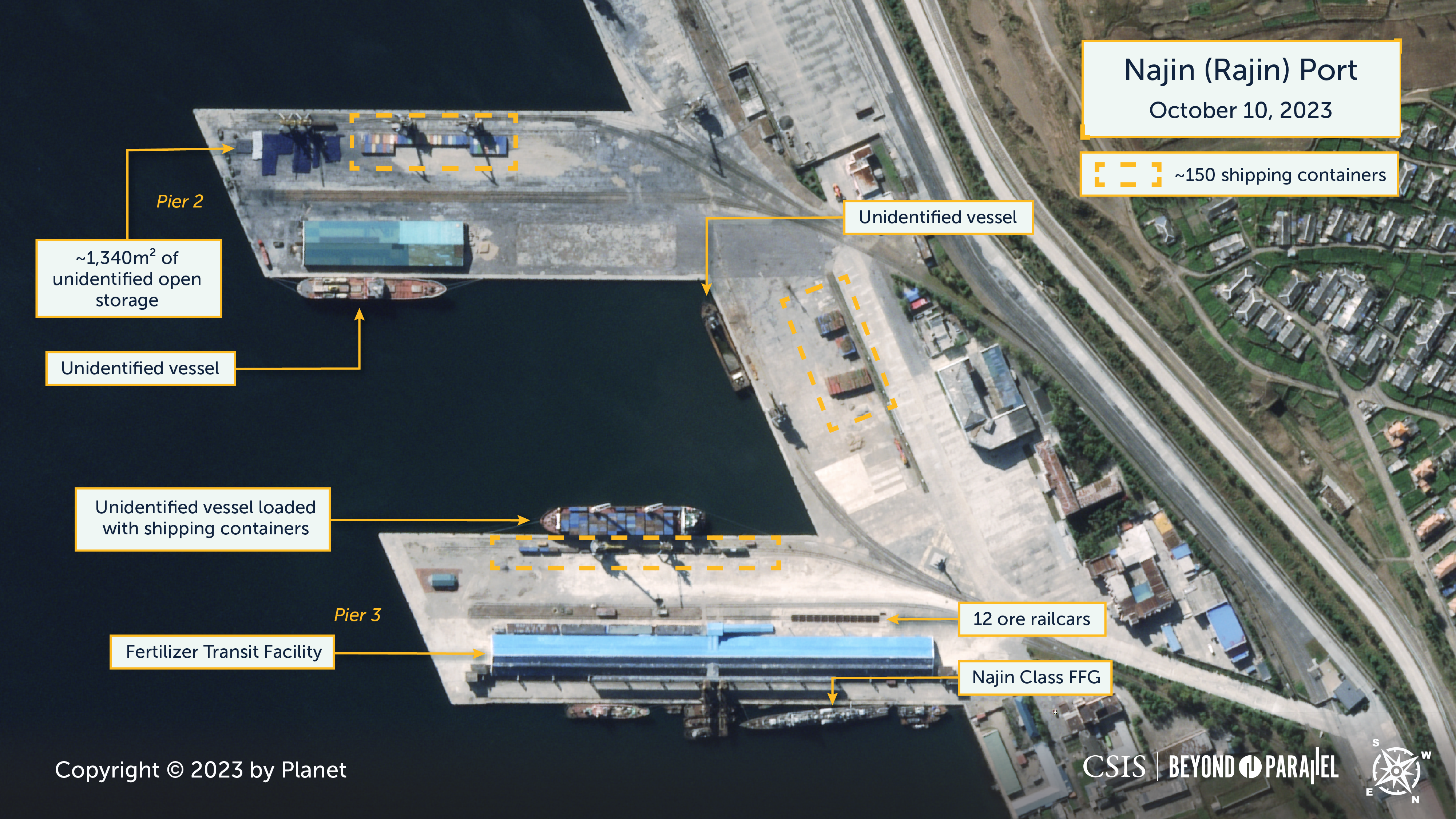
In an October 10, 2023, image, activity is observed at both Piers 2 and 3 with a total of approximately 150 shipping containers present.1 Pier 2 has traditionally been used for both coal and break/bulk cargo handling but is observed in the image as being solely dedicated for loading and unloading of goods. On the pier are shipping containers and approximately 1,340 square meters of unidentified bulk open storage.2 On the east side of the pier is an unidentified, approximately 102-meter-long general cargo vessel. This vessel has regularly been observed here or at Pier 3 since at least 2010 and is not believed to be involved in arms transfer activities.
Along the quay in between Piers 2 and 3 is an unidentified, 63-meter-long ore carrier. This vessel is observed at this location in all images examined for this report. Dockside of this vessel is a storage area for shipping containers, where containers are observed consistently throughout the studied period.
Pier 3 houses the “Fertilizer Transit Pier” and has also been used for both break/bulk cargo handling and berthing of vessels using the shipyards. Along the pier’s west side is an unidentified, 102-meter-long, fully loaded container ship. On the pier is a locomotive with ten railcars, four shipping containers, and 12 ore railcars. The latter is present in all imagery examined for this report and very likely stored here. A Najin Class guided missile frigate (FFG) has been present along the east side of the pier since 2017 and about nine miscellaneous small craft. Few small vessels have been observed here since at least 2016, as this side of the pier is generally used for vessels undergoing maintenance in the adjacent shipyard.

October 16, 2023

Six days later, on October 16, 2023, ongoing activity is observed at both Piers 2 and 3, with a dramatic increase in the total number of shipping containers present, at approximately 430. On Pier 2, along with the shipping containers, is a locomotive with 11 railcars, two separate large railcars, and about 1,600 square meters of unidentified bulk open storage. A tugboat is now tied to the ore carrier along the quay between Piers 2 and 3.
The fully loaded container ship previously berthed along the west side of Pier 3 is no longer present, but shipping containers are still on the pier.
October 23, 2023

Less than a week later, on October 23, 2023, an image once again shows a significant increase in activity in both piers, with the total number of shipping containers present throughout now reaching approximately 780.
At Pier 2, an approximately 126-meter-long container ship is now present along the west side of the pier, either loading or unloading shipping containers. It is highly probable that the vessel is the Angara, previously identified by the White House as being involved in the transfer of military equipment and munitions at this port.3 Also on the pier are a locomotive with 13 railcars, shipping containers, and approximately 1,250 square meters of unidentified bulk open storage. The tugboat previously tied up to the ore carrier between Piers 2 and 3 is no longer present, and the number of shipping containers present on Pier 3 has increased since the last observed image.
November 12, 2023
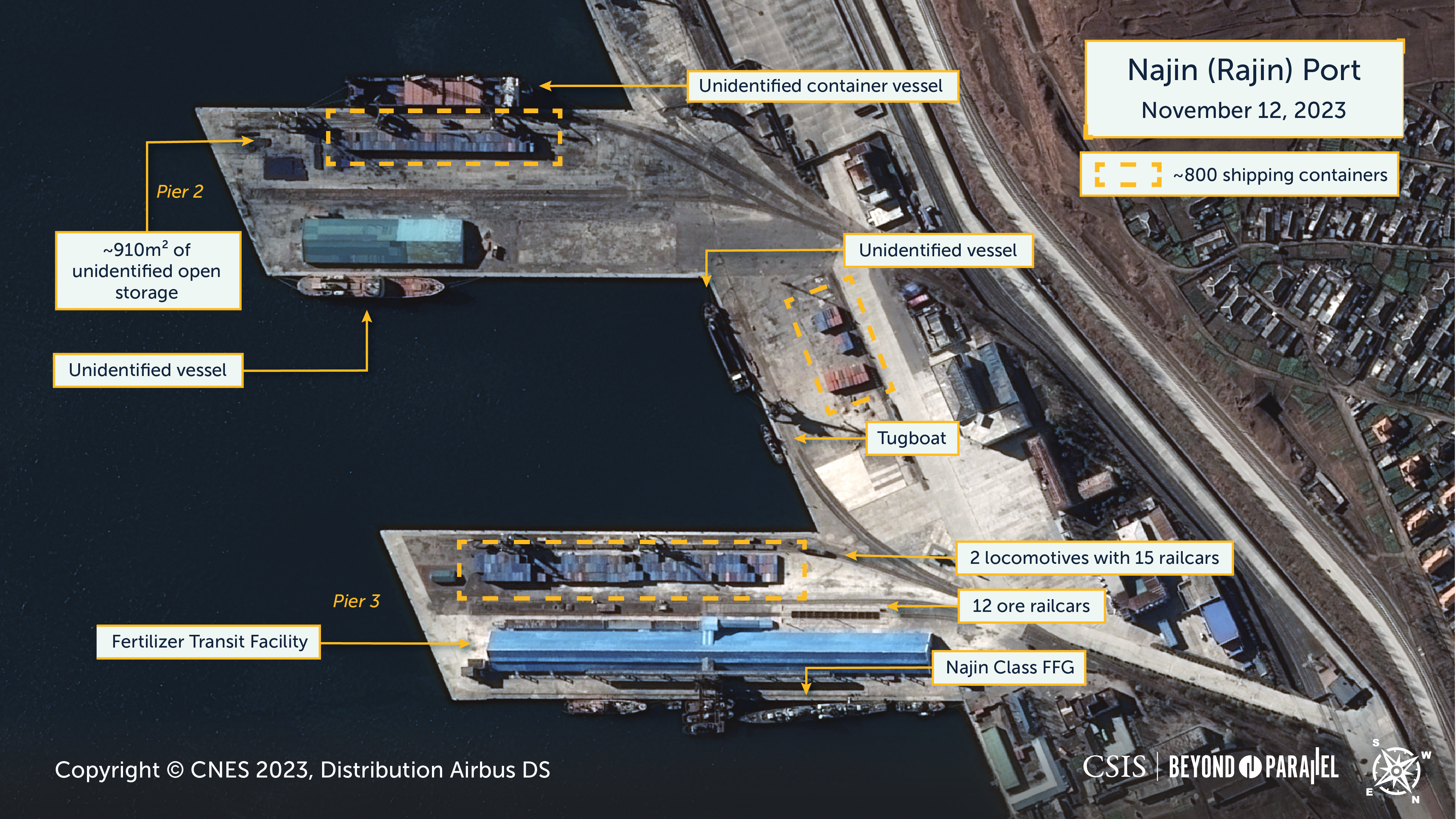
A satellite image acquired on November 12, 2023, shows ongoing activity around both piers, slightly increasing shipping containers to approximately 800. At Pier 2, the unidentified container ship appears to be almost finished loading shipping containers and bulk cargo. An image acquired the following day shows the vessel has departed and a dramatic decrease in the number of shipping containers present. The area occupied by unidentified bulk cargo has been reduced to approximately 910 square meters.
Along the quay between Piers 2 and 3, a tugboat has returned. On Pier 3, the number of shipping containers present is approximately the same as in the previous image, although rearranged. There are also 15 railcars and two locomotives present.
November 15, 2023
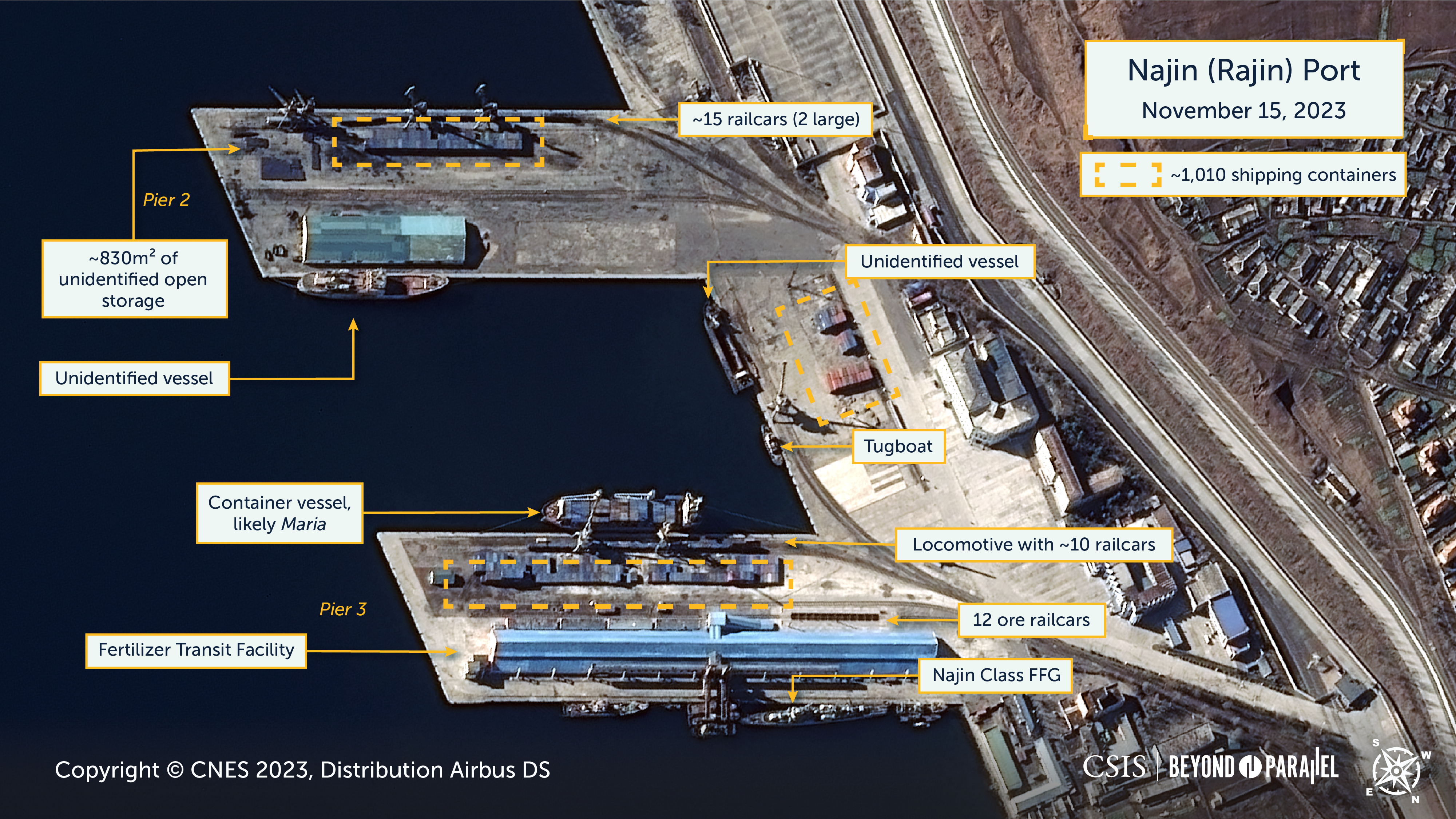
Satellite image acquired three days later, on November 15, 2023, shows an even further increase in activity along both piers, with the total number of shipping containers now reaching approximately 1,010. On Pier 2, the number of containers remains approximately the same from three days ago, but there is an addition of 15 rail cars that are empty. The unidentified bulk open storage decreased to approximately 832 square meters.
Along the west side of Pier 3, an approximately a container vessel that matches the dimensions and characteristics of the Maria, a vessel previously identified by the Royal United Services Institute as having been involved in NK-Russia transfers,is now present.4 Additionally, on the pier next to the hundreds of shipping containers is a locomotive with approximately 10 railcars carrying shipping containers.
November 20, 2023
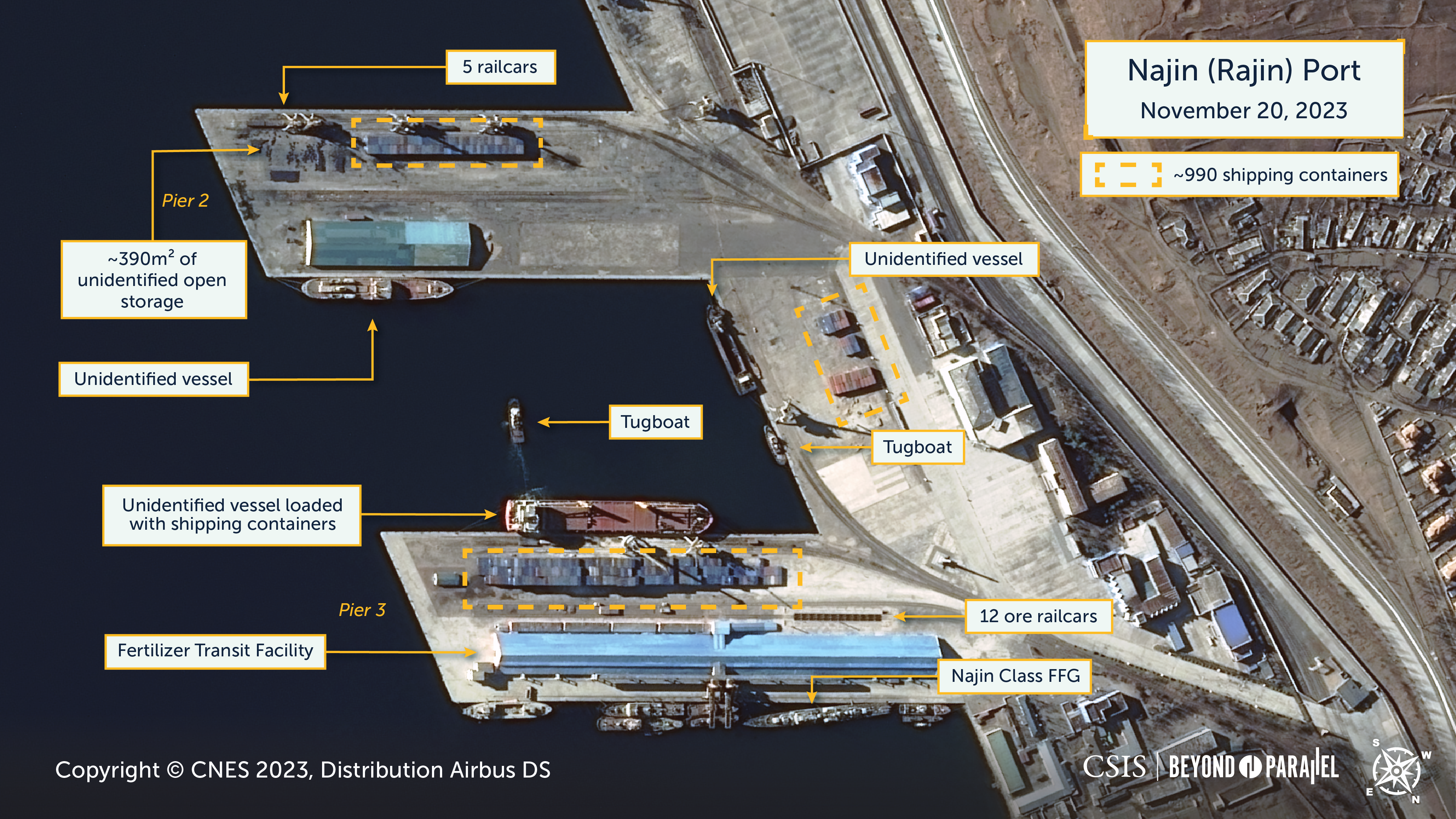
On November 20, 2023, Najin Port continued to show ongoing activity around both piers, with a slight decrease in the number of shipping containers to 990. On Pier 2, both the number of shipping containers and the size of the unidentified bulk open storage have decreased, and there are approximately five rail cars present.
Between Piers 2 and 3, a second tugboat appears to be assisting a recently arrived container ship. This vessel, measuring approximately 138.7 meters long, is berthed alongside the west side of Pier 3, where shipping containers have slightly increased compared to five days ago.
November 25, 2023
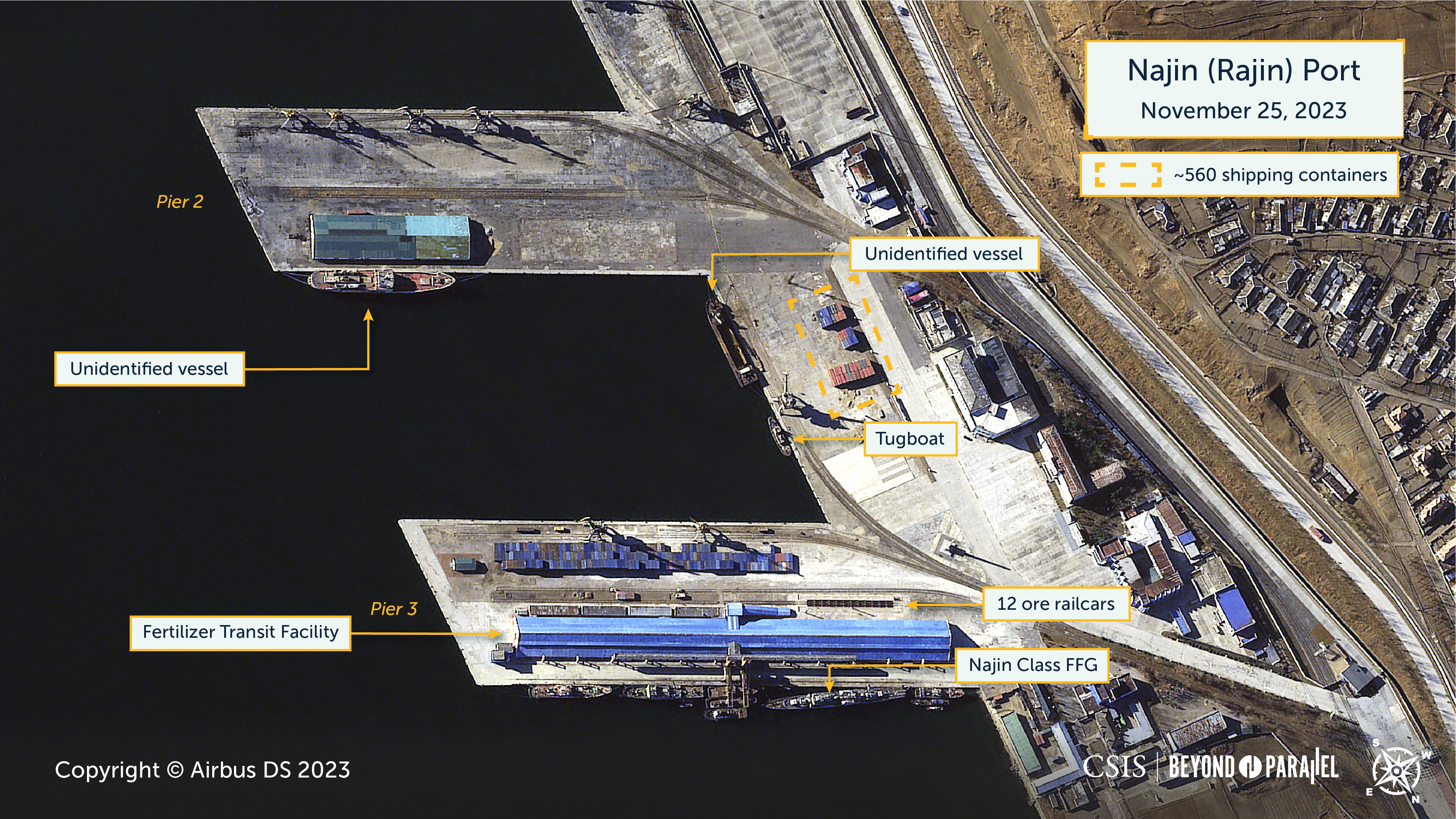
Satellite image shows ongoing but decreasing activity five days later, on November 25. Approximately 550 shipping containers are now observed throughout the port. At Pier 2, no railcars or shipping containers are present, and there are only minor scattered remains of the unidentified bulk open storage previously located here.
Between Piers 2 and 3, the second tugboat is no longer present, as is the case for the container ship, which was previously berthed along the west side of Pier 3. At Pier 3, the number of shipping containers has also decreased.
November 30, 2023
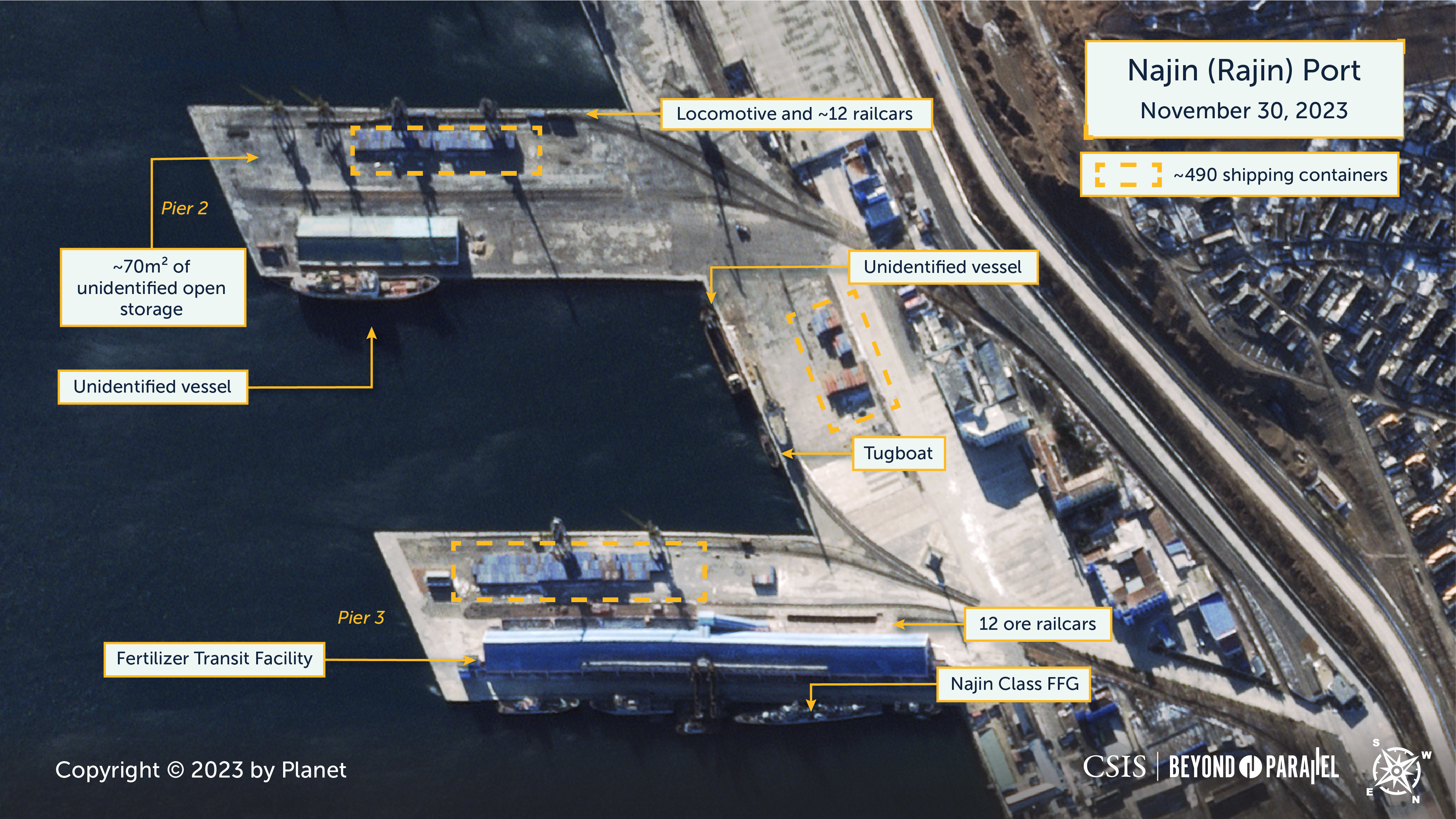
By November 30, 2023, activity continues to decrease around both piers, with a declining number of shipping containers to approximately 490. However, on Pier 2, the number of shipping containers dramatically increased over the past five days, and there is a locomotive with approximately five rail cars and seven shipping containers present. The unidentified bulk open storage has increased slightly to approximately 70 square meters. At Pier 3, the number of shipping containers present has decreased.
Activity at Najin Railyards
At the Najin railyards immediately north of the port, a notable increase in rail activity is observed between September and November 2023 compared to the same months in 2019, before COVID. The seems to have started sometime in late August or early September of this year, just a few weeks prior to the Kim-Putin summit in Russia in mid-September.
The observed activity and its timing suggest a correlation between this increased activity and the reported arms and other trade with Russia through the port of Najin and the rail crossing at Tumangang-Khasan during the same period. How this increased rail traffic will impact the already poor condition of the northeastern section of the Pyongyang-Najin rail line is presently unclear.
References
- The naming convention for the piers within the port of Najin differs between North Korean and Russian sources and those of official U.S. sources. For this report, we have used the U.S. convention numbering them running from south to north as Pier 1, Pier 2, and Pier 3. ↩
- The number of shipping containers estimated to be present in this report are broad approximations derived from satellite imagery. The fact that this imagery was acquired at different resolutions, from multiple off nadir angles, and with long late fall shadows makes precision extremely challenging. As such, these approximations should be viewed cautiously. ↩
- The Russian-flagged Angara (IMO 9179842, MMSI 273210440) has also been identified by RUSI in their recent report. For more, see James Byrne, Joseph Byrne, and Gary Somerville, “The Orient Express: North Korea’s Clandestine Supply Route to Russia,” RUSI, October 15, 2023, https://rusi.org/explore-our-research/publications/commentary/report-orient-express-north-koreas-clandestine-supply-route-russia. ↩
- James Byrne, Joseph Byrne, and Gary Somerville, “The Orient Express: North Korea’s Clandestine Supply Route to Russia,” RUSI, October 15, 2023, https://rusi.org/explore-our-research/publications/commentary/report-orient-express-north-koreas-clandestine-supply-route-russia. ↩
